There is no Judas in Ukrainian version of the Last Supper
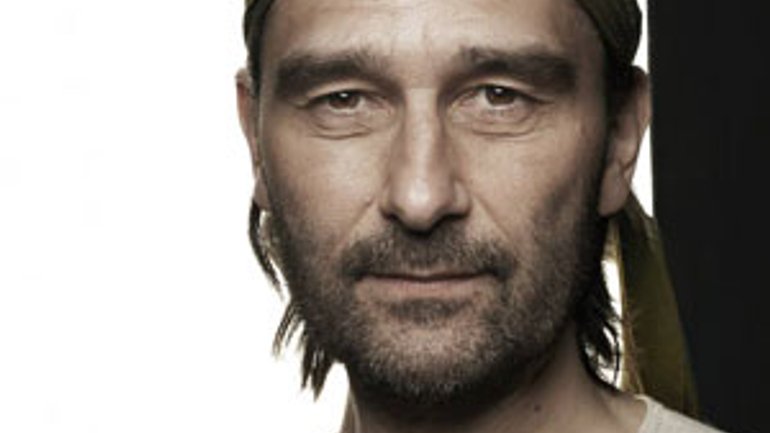
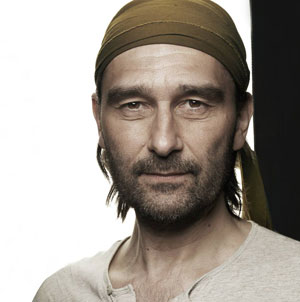 During the major Christian holidays - Christmas and Easter, French photo artist Yuri Bilak visited the ATO zone. He chose these dates not accidentally, because a story was drawn up by his creative imagination: “A priest and a soldier.” Along with photographs made on Maidan (Yuri visited it six times), the shots from military zone will be included in his new album, which is just being prepared. The main thing is to find funding ...
During the major Christian holidays - Christmas and Easter, French photo artist Yuri Bilak visited the ATO zone. He chose these dates not accidentally, because a story was drawn up by his creative imagination: “A priest and a soldier.” Along with photographs made on Maidan (Yuri visited it six times), the shots from military zone will be included in his new album, which is just being prepared. The main thing is to find funding ...
While Yuri processes everything that got into the shot in Donbas, his work, which he named ‘The Last Supper’, became incredibly popular on web. The military and a priest are sitting at the Easter table. The photographer was asked many times, “Who is Judas?” In fact, the photographer recorded not 13 people, but 12 - including the priest. So, as the noted photographer, there is Judas Leonardo da Vinci’s painting "The Last Supper" and there is no Judas in his photograph ...
Generally speaking, one might write a lot about Yuri Bilak’s visits to Ukraine, because since 2004 he began to travel regularly to the sites of his parents - Orestes and VasilisaBilak, natives of the village of Barna, Vyzhnytsya district of Chernivtsi region. This photo of his parents Yuri took specifically for RISU.
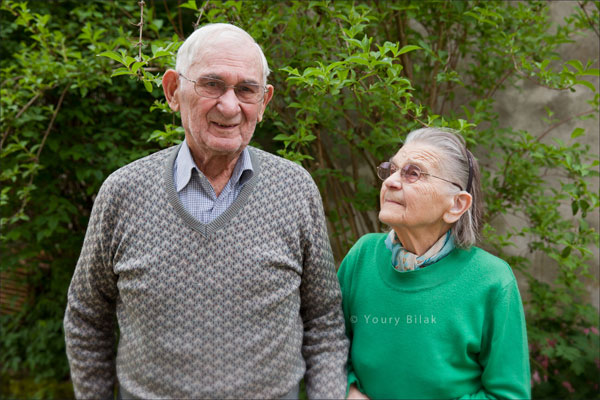
Despite the fact that Yuri was born in France, he speaks Ukrainian well (with a slight French accent), and he photographed Ukraine not just to please parents. Surely genes play a role ... Therefore he traveled in the Carpathians and lived among Hutsul people (as a result – a photo of "Hutsuls"), descended the mines in Donetsk, lived with the Crimean Tatars, making photos of famous people of Ukraine ...
“The military and medics accidentally sat down as in the painting by Da Vinci”
- Yuri, many photographers visited the ATO zone, and took unique photos there. But none of them ever paid attention to the theme “Christmas and Easter in Donbass”. How did this idea come up?
- You already know me a little bit, and you know that I love contrasting pictures. Contrast in the light and in the topic. For me Easter - is the biggest holiday in Ukraine. I was not about photos. As a person, I just wanted to spend Easter together with the military, to lift their spirits, to show that the Diaspora cares about them. However, coming here as photographer I always had in mind the image of a priest, who administers Eucharist for the military. Very often in Ukraine the Paschal Liturgy is performed at night, when all around is dark, only candles are lit. And this mysterious atmosphere is very interesting to me.
At Easter, I visited in Artemivsk and south of Artemivsk up to the frontline. At Christmas, I visited other militaryunitsinLysychansk, Slovyansk, Kramatorsk. It was already my second trip to Donbas, for the first time I went there last fall. At Easter, I was luckier because I spent these days as wanted: I stayed together with the military, slept, ate with them. I always like doing these things in Ukraine.
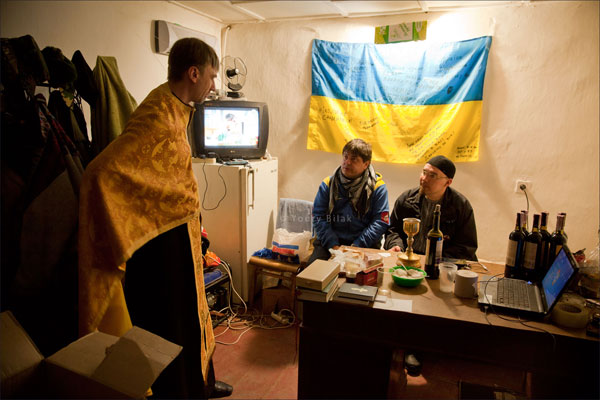
- Have you met many priests?
- Well, I have met only Father SerhiyDmitriev, who, in fact, is a hero of the photo “The Last Supper”. I will tell you that if I find a desired scene, or a man, I try to follow this man and not to be distracted any more. To make a profound report I need to be with this person as long as possible. Therefore, one priest at different moments is enough for me as a photographer. I met Father Serhiy in Kyiv; he is Orthodox. I was very deeply moved what a deep humanist he is. His life is very interesting, too. From what I know, he was born in Russia and lived there. He arrived in Kyiv, entered the seminary of the Moscow Patriarchate, and received a parish in Kherson. During the Maidanprotests, he supported the Revolution of Dignity and decided to move to Kyiv Patriarchate with the parish. This is his second Easter in the East. He often goes there, he knows very well the 30th Brigade. Wherever we went, everyone knew him well, all soldiers knew him well.
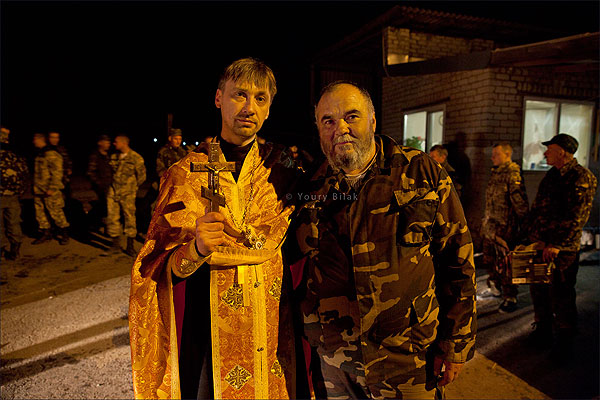
- The photograph of “The Last Supper” - it is accidental or you thought over the plot beforehand?
- No, no and no again, I did not plan anything like this and did not even think about it. It was impromptu. The only thing that I love to create such pictures that are based on painting. So the Liturgy ended (and we were at the first-aid post) and there was a table at which doctors have dinner. People sat down and I saw a familiar theme.
They sat in a way it really reminded me a picture of Da Vinci. There may have been five people, and I asked some more to sit at the table. Together with the priest, there were 12 persons. Usually I use a different camera for such photos. But I would have to run to the car, fix the light. I did not want to lose the atmosphere and did not want too much staging. I did not want to say, “You look there, and you look here.” I wanted everything to be natural. Quality was not what I wanted. Maybe it is even positive, for this fault is like a painting where there is no clarity. The fact that I lost some quality but I gained much more in the atmosphere. 10 seconds and the picture was ready. There is little light just falling on people, those old walls of the unfinished plant, the Mother of God on the wall ... I brought some to the table, including fish, which is a symbol of Christianity.
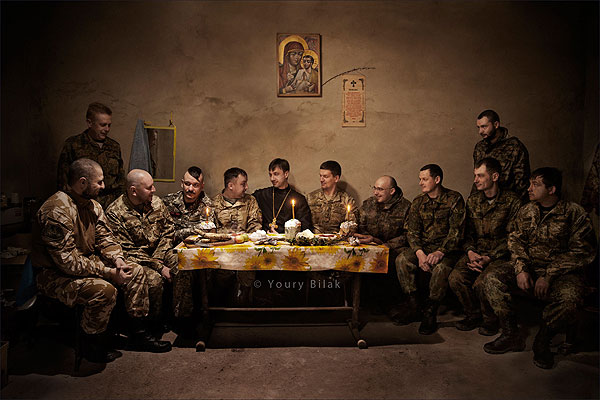
The painting by Leonardo da Vinci includes 13 people together with Jesus Christ. However, on my photos there are 12 together with a priest. To make the photo closer to original I added another man in Photoshop. Soon there were many comments on the Internet, asking who Judas was. I did not like this question. Why should one look for Judas among Ukrainian military? Therefore, I removed that man I added. Moreover, I decided that this would be the official photo of my Last Supper: 12 people together with the priest.
“In Lyon we were not divided into Orthodox and Catholic”
- What was Father Serhiy’s reaction?
- He loved it. He said that it was a work of art. He had no objections to this work. Although, actually, I have done nothing. I have just witnessed a miracle that happened to me. Nevertheless, the picture is symbolic for me as Father Serhiy represents the man who was in the Russian world and left it. He is sitting in the middle as if connecting eastern and western Ukraine. In the photo, he looks at the left, and left just sit doctors. The priest heals the soul, and doctors heal bodies. So, it is symbolic that he is turned to doctors.
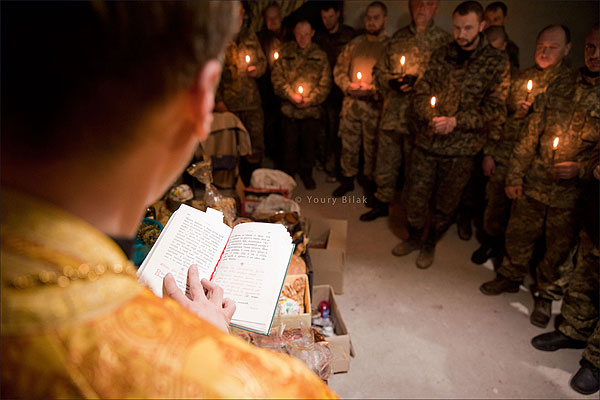
- Who are these guys in your pictures?
- On the right side of the priest there is SerhiySobko, battalion commander, who recently was conferred the title of the "Hero of Ukraine", Ukraine's Armed Forces lieutenant colonel, commander of the mechanized battalion of the 30th separate mechanized brigade of the 8th Army Corps. That is, the military are on the right, the doctors and ambulance drivers are on the left.
- Yuri, in order that your shots rendered a good atmosphere of major religious holidays, one is to know well the content of these holidays. Did your parents raise you in the Christian spirit?
- Yes, I am a Christian. I know everything from my childhood. For me, Easter evokes such associations in my mind: a large can, in which the mother made dough for cakes, it grew up and overflew the can. I remember the smell of cakes. When I was very small, my grandmother took a wax pen, warmed it on gas and painted eggs, my mother stood beside her. My grandmother, like my mother and my aunts are Ostarbaiters. My uncle, who was a member of Bukovina kurin, found them in 1947 and brought to Lyon. My grandmother lived with us in one apartment.
- Did you all go to church?
- Yes, of course. When I first went to Ukraine to shoot Easter pictures, I was not searching for a plot in the city and in the countryside, in nature. For in Lyon we blessed Easter cakes in the daytime. And I was wondering how this happens at night - as it is common in Ukraine. In the village of Knyazhdvir, near Coloma, I found this atmosphere: at nighttime people came out with basket, beautiful green grass. It was like a dream for me. In Lyon, there were few Ukrainians that time, and we were not divided by churches. An Orthodox priest came once in two weeks, then a Greek Catholic priest. Therefore, we all attended both Liturgies. Therefore, frankly speaking, I find it hard to distinguish between the two ceremonies. And I say the greeting “Christ is Risen - Indeed He is risen” automatically from my childhood.
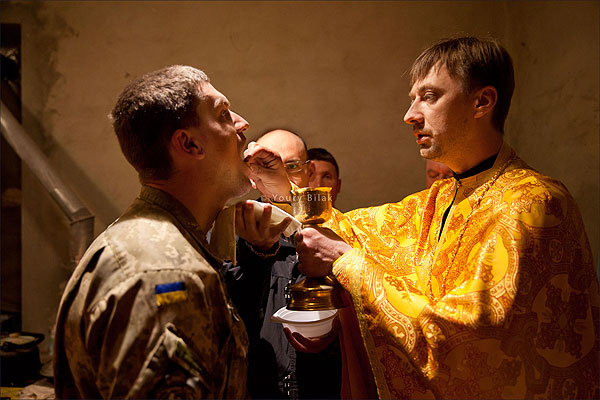
- Many military who are fighting have found God for the first time. Have you noticed this?
- All soldiers that I have seen, it seems that most of them come from NovogradVolyn. So they have a habit of going to church, their attitude to the priest was warm. The priest knew them. When I photographed Easter, I felt the believers who came to the Liturgy.
- What Easter events did you record in the East?
- When Father Serhiy blessed the cakes and sprinkled everyone. Father Serhiy sprinkles abundantly, people get completely wet. I photographed the Savior’s festival in Poltava, and Hutsul regions and I have some experience with sprinkling. But Father Serhiy sprinkles from all his heart sprinkles! And all that funny jokes he says when sprinkling. Here is a turning point: when the Liturgy is over, you can feel very well that there is not just a priest before you; it is a person who has just served worship and turned into an ordinary friend for the soldiers. And it is very interesting to me. Then I take off the camera and put it behind me so that father sprinkled me too.
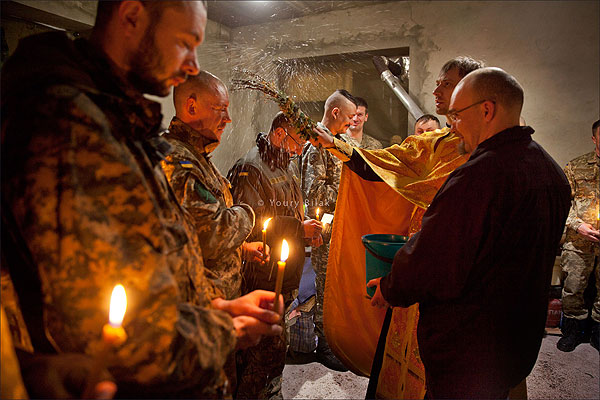
"My father is writing a memoir about his participation in the Second World War"
- Did you eat Ukrainian dishes with the soldiers, or something you had brought from France?
- I had brought French sausage, chocolate and coffee. When I go to Donbas and I have free space in my suitcase, I always try to take some gifts for soldiers. Even at the airport, I buy a bottle of wine.
- Do your parents know about your trip to Donbas?
- No, they do not. They are elderly people and would be worried a lot. They know that war is hell because they have survived it themselves. When in the early 90s, Ukraine received independence, all our people overseas rejoiced. I know if it happened sooner, my parents would have returned to live in Ukraine. But when they realized that Ukraine only seems to be free, while the government remains communist ... We do not talk much about current events, because my parents are over 89 years old, but sometimes I can feel their pain ... representatives of their generation in France have almost gone ... When I first went into the ATO zone in November, I also took photographs in hospitals, I talked with young people who had undergone leg amputation.Once I saw a guy who had the same amputation as my father had (he lost a leg in World War II, but in France). I felt very sorry for that young guy, but looking at him, I saw my father ... I have never spoken with my father about his tragedy, so as not to hurt him, I know only superficially about it...
- You have seen peaceful Donbas and its present state. Can you compare?
- In 2006, I photographed the miners. What I feel now that I have not felt that time: a lot of people look at Ukrainian military as enemies. It seemed then, in 2006, they felt themselves Ukrainians. Now if they regard the Ukrainian military as enemies, who are they? … I cannot understand this. Who do these people think they are, Ukrainians or separatists?
- When reviewing your photos from the ATO, everyone reads that they are taken by a Frenchman, but few people know that World War II affected your family, too. Do you discuss this subject at home?
- I always do! I grew up with that. Even now these talks are continuing. For my father is writing his memoir which is be published soon. We go every year with my father to the place in France where he fought and his fellow Ukrainians died. My father fought in Bukovynakurin on the side of the Germans against the Soviet army. Later they came to Belarus, where continued fighting against the Red Army. Then they were sent to France in 1944, and their battalion sided with the French resistance movement. Fighting against the Bolsheviks would make little sense. Fighting against the French made no sense any longer. So they immediately moved to French side. They fought with the French, and then the Soviet delegation came and said the French say, we want to make our brothers back home. The French responded, “Yes, you are welcome”. But the Ukrainians told them, if they returned, they would fight against them, too, i.e. against the Soviet army. Here, the French realized that they were not brothers for these Ukrainians. For all of them, and for my father there was only one way out: to join the French Foreign Legion to avoid returning home and further combat Red Army soldiers. Therefore, they fought in Lyon with the French against the Germans.
My father is writing about it now, because this period of war has not been studied much. When a monument to Bukovynakurin opened in Chernivtsi, my dad used to visit it. Earlier my father had also visited Chernivtsi and talked with those who stayed with the battalion who had managed to return from Siberia.
- Have you got any keepsakes from the fighters?
- In the East, I broke my headband. So I say to the guys: “Find me something to fix my hair so that it does not interfere with the photograph.” So they gave me a kind if scarf they wear themselves. In Kyiv, my friend Daria Tishchenko-Zhuravel have taken this picture of me (photo at the top). It will be a reminder that I have been in the East.
Photo by Yuri Bilak









